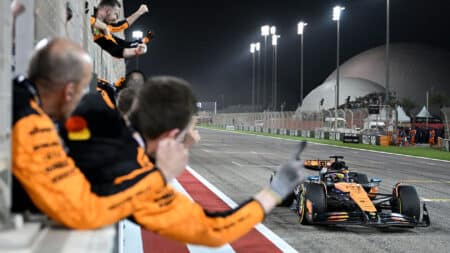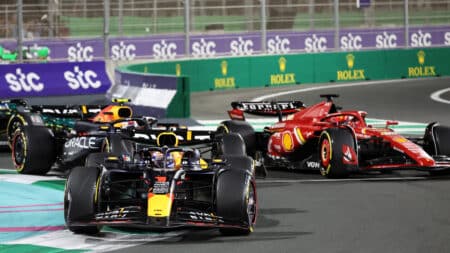
Alonso: Verstappen not a threat to my Aston Martin F1 seat
Fernando Alonso says it's "very unlikely" Max Verstappen will be his team-mate, and rejected the idea that he could be replaced by the Dutchman
Compromise solution for this season
Here’s what GPDA President Alex Wurz said to the BBC last week when articulating the F1 drivers’ frustration with the current heat-degrading concept of Pirelli tyre and their desire to see a replacement from 2017 on which they can push to their maximum. “The drivers want to underline very clearly that they would love Pirelli to produce a tyre which goes faster around corners as well as being safe. If we get sticky tyres, we will have happy drivers, and happy drivers means authentic and honest performance, pure message for the product and driving the cars to the maximum. That’s what we want and, according to the fan survey we did last year, what all the fans expect.”
There is currently a big push from both drivers and teams for the heat-degrading concept of tyre to be abolished. Pirelli says it would be happy to comply, to create a more traditional racing tyre where performance drop-off is determined only by tread wear and which can thereby be raced to the maximum potential of both car and driver. But that this contradicts what it was originally tasked to do by Bernie Ecclestone. “We are prepared to do what is required by the sport,” says Pirelli’s Paul Hembery, “but those requirements need to align between drivers, teams and the promoter. We need clear direction – and going forward from there we need to extensively test any new solutions. So far we have had three test days in three years. If we are going to make significant changes to the tyres for 2017 we need many more tests than that.”
In the meantime, for this 2016 season, Pirelli is trying a compromise of sorts with a range of tyres that have a significantly shallower tread before reaching an under-compound that has very low grip. In this way, it hopes to be able to create multi-stop races by tread wear rather than heat degradation. But it will be a sudden performance drop-off once that under-layer is reached – so still not the traditional racing tyre, but potentially allowing Pirelli not to include heat-degrading composites into its compounds.
Some in the paddock have questioned whether the Pirellis really have been deliberately engineered to heat degrade the way they do – or whether that’s simply how a Pirelli behaves. “Absolutely, these tyres have heat degrading composites within the compounds,” confirms Hembery, “and that’s an inherent part of the philosophy of the tyre that was designed to fulfil the original brief we were given by the promoter – which was to create unpredictable races.”
From the archive: Mark Hughes on F1 trying to recapture its fanbase (July 2015)
This whole issue is a complex – and frequently misunderstood – one. It is wrapped up not only in the drivers feeling they are driving to false limits in the Pirelli era, but in the attempts at making the 2017 cars faster. This latter process – the wisdom of which is debatable anyway – was recently pulled up short by Pirelli pointing out that the aero loads that would be created would potentially overwhelm the current tyre concept.
It’s necessary to properly understand the distinction between deliberately engineered heat-degrading tyres and a normal racing tyre. Including heat-degrading composites (essentially plastics) into the compound means that, at most tracks, driving flat out for three or four laps would destroy the tyre even while is still retains plenty of tread. The ‘plastics’ permanently change their chemical structure once beyond a certain temperature threshold – and will not return to their original form. The ‘fried’ plastics lose the tyre much of its elasticity, making it dramatically slower and no matter how gently it’s treated subsequently it will not recover. Driving it one or two seconds off the pace (depending upon track layout, compound softness, track temperature etc) keeps it below that temperature threshold and allows reasonable stint lengths. Thus at most tracks the drivers are well below their own limits and those of the car for big stretches of the race, typically only letting rip just before the pit stops.
A conventional racing tyre with none of these heat-degrading materials inside still loses performance as it becomes more worn but can be driven flat out for the duration of its tread life. As the tread becomes thinner it loses some of its elasticity (albeit nowhere near as dramatically as a ‘fried’ Pirelli) and therefore performance, but the performance loss is nowhere near as dramatic or sudden. The compounds of these tyres can be as soft or hard as is deemed appropriate, so that they can still be short-wearing and fast or long-wearing and slower. To infer that the only alternative to heat-degrading tyres is ‘wooden’ long-wearing rubber – as some have done, even within the sport – is a complete misnomer. Judge the compound softness for the demands of the track correctly and short-life tyres with multiple-stop races – flat-out the whole way – are perfectly feasible, without the ludicrous situation of the fastest cars and fastest drivers falsely slowed by deliberately performance-limiting tyres.
However, prolonged flat-out running naturally places greater strain on the tyre’s construction. And this is where Pirelli gets concerned about being tasked to come up with a proper performance tyre without extensive testing. The current construction may be adequate for the relatively low loads imposed on them by drivers lapping a couple of seconds off the pace, but the stress on the construction increases exponentially if the compound allows the tyre to be driven flat-out for the full life of its tread. Already, there is the suspicion of a weakness around the shoulder area – the tyre failures of Rosberg and Vettel at Spa were both around the shoulder – and it’s clear a new, beefier construction would be required. “Yes, it would need a different approach,” allows Hembery. “Also bear in mind that the cars are a lot heavier now than a few years ago, by around 200kg. Back in the refuelling era we had 500kg cars doing 18-20 laps on the tyres. Now we have 700kg cars doing 30-odd laps or more. That’s why we suggested bringing back refuelling, but there was no appetite from the teams for that, so we are left back at square one. We need a clear direction of what we are being asked to achieve. But we need it very soon because we would have to have these tyres out testing by November of this year. Time’s running out.”
From the archive May 2009: Bernie Ecclestone – Not shy and not retiring
In the meantime, the ‘thin tread’ tyres of this season might allow the drivers to push more. But that remains to be seen. The teams will work out if the fastest way to run the race is to go flat-out until they are almost down to the low-grip under-compound – when performance drop-off will be dramatic. Or whether it would be faster overall to drive them a little off the pace, just like they were heat-degrading tyres, and thereby get a few laps longer on the stint and thereby saving an extra pit stop. It could be that this varies from track to track. It would seem to be worth a try as an interim solution. But the essential point remains: F1 should never be about deliberately driving whole chunks of a race off the pace. If F1 is to remain with Pirelli – and as late as Autosport International at the NEC last week, the Pirelli deal from 2017-on announced on the grid at Sochi had still not actually been signed – then Pirelli must be guided towards supplying a true racing tyre, and given enough time to test it.

Fernando Alonso says it's "very unlikely" Max Verstappen will be his team-mate, and rejected the idea that he could be replaced by the Dutchman

Former FIA second-in command Robert Reid has expanded on the reasons behind his exit, saying that he was excluded after raising concerns over "fundamental principles" such as transparency and accountability

There's several key differentiators that could help you win big in F1 Fantasy for this weekend's 2025 Saudi Arabian GP. Here are our predictions; tips on drivers to avoid; which chips to play and further analysis

Can Red Bull rebound from its poor Bahrain showing? And will it be Piastri or Norris leading McLaren's charge? Here's the five themes to watch for at the Saudi Arabian GP